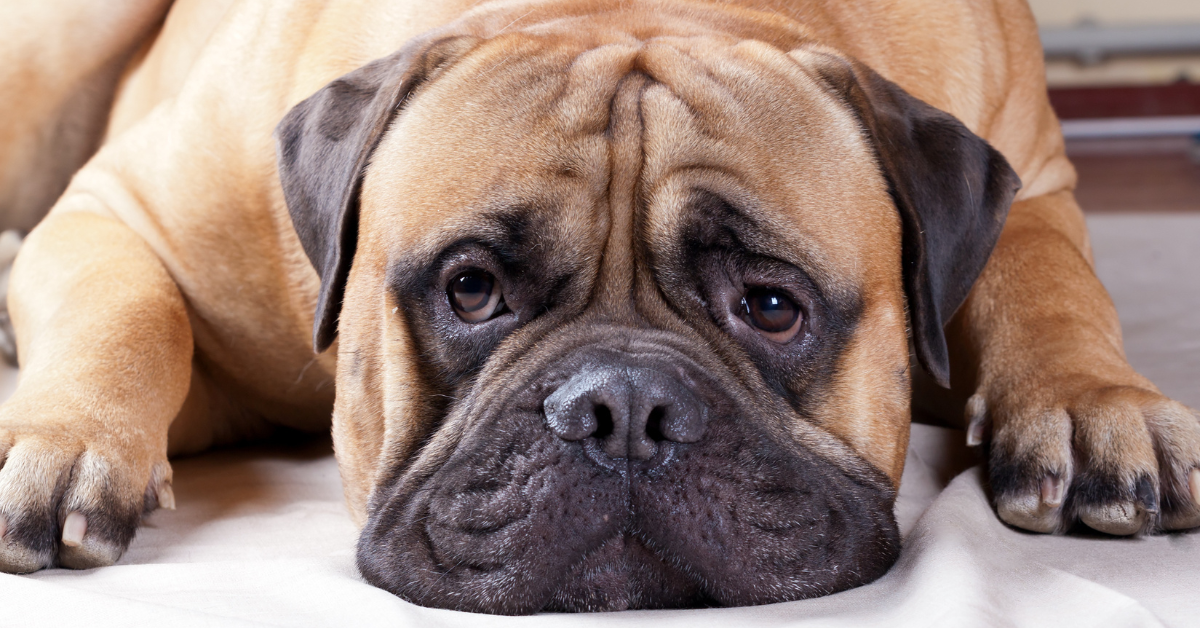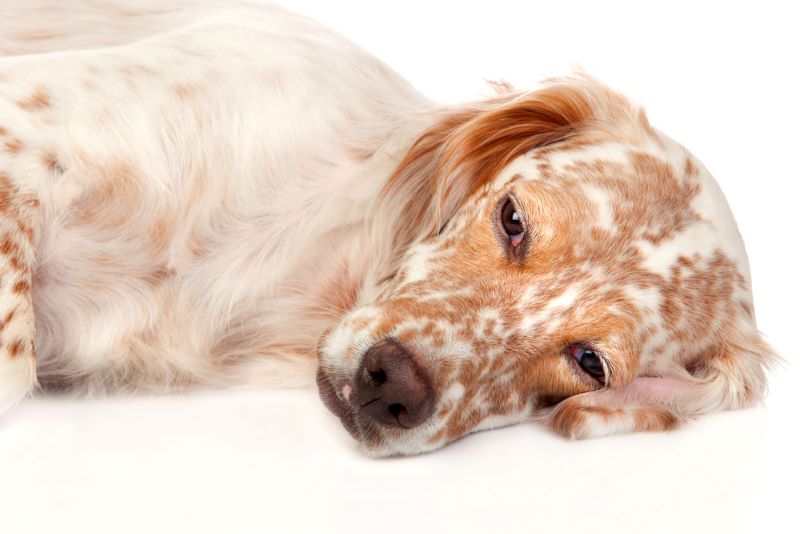“My puppy had a beautiful coat of white when I brought him back yesterday. Now he’s dotted like a Dalmatian!” – Concerned dog owner.
Ok, that’s probably just a little bit exaggerated.
But, why is your dog’s fur changing color in spots?
Though your pooch is undoubtedly just as handsome and cute as before, it can be worrying if the spots perhaps signify something more sinister going on inside.
While this is not usually the case, there are a few different potential factors that could influence a canine coat color change (try saying that quickly 5 times in a row!). These can include:
- Natural aging;
- Hair shedding or grooming;
- Staining;
- Hormones;
- Injury;
- Illness; or
- Nutrition.
Now, let’s take a closer look at the causes of this phenomenon!
Why Is My Dog’s Fur Changing Color In Spots?
Dog coloration can be very complicated.
Even understanding the genetics behind it takes some studying, and when you add in color changes it becomes even more challenging to understand.
There are many different reasons as to why your dog’s fur may change colors in spots. Some of the causes are natural, while others may be a cause for concern. Many of these issues may require vet care and assistance to fix.
Age
There are a few times in life that your dog’s fur can change colors as they mature from a puppy to a full-grown adult. Depending on the breed, the colors change differently as the puppy coat is replaced with an adult coat during the aging process.
For some dogs, the fur gets darker. For others, it lightens up.
Some dogs will even add greys and whites to their coat in the first 12 months. All in all, puppy fur changing color in spots is a pretty normal sight to see!
Dogs’ fur also changes in adulthood as they get older. Like humans, older dogs can start seeing their coats thin out and change color. They can also start accumulating more graying fur.
This can usually be seen around the face the most, but it can happen across the whole body as well.
You may also see the dog’s coat get lighter as they get older, even if it doesn’t grey. Pigment uses a lot of energy to make, so it starts becoming less important in older dogs.
Injury

Unbeknownst to most, injuries or wounds such as skin lesions (and the subsequent healing process) can sometimes cause a dog’s coat to change color! It is thought that damage to hair follicles is the primary reason for a color change in this instance.
The coat may become darker around a wound site (such as if you accidentally cut your dog with scissors during grooming) because of an increase in melanin to the area that is intended to facilitate quicker healing.
The color change from injury may only be temporary, but in some cases can become the new permanent coloration as well.
In situations where hyperpigmentation is prompted by injury, only the area around the wound will change color. The rest of the coat will remain the same as before.
Hair Cuts
Sometimes even a trip to the groomer’s can make your dog’s coat change colors.
Groomers have been known to go so far as to warn repeat customers beforehand that long-term shaving of a dog’s fur can result in color variations due to textures changing and the new coat coming through.
Generally, it is more common for lighter hues to emerge after repeated haircuts, and any changes are usually more obvious if you choose to cut the coat very short.
As the hair grows back, you may notice new colors have emerged where they didn’t exist before.
This is also likely due to the fact that dogs have an undercoat that is normally invisible under a top coat. Thus, when the top coat is cut back or otherwise heavily shreds, the frequently differently-shaded undercoat is then revealed!
This is particularly evident in my own dog Olliver, who is a brindle Cardigan corgi. As he goes through his yearly big hair sheds, more of his lighter brown shades emerge from underneath in vivid streaks.
Eventually as his top coat grows out again, he goes back to his normal darker brown/black color!
Illness

Many illnesses or diseases can cause your dog’s coat to change color. Commonly, superficial skin problems such as parasite bites (from fleas or ticks) or hives can cause damage to hair follicles and skin, and result in a color variation.
Diseases such as-
- Demodectic mange (caused by mite infestation);
- Malassezia dermatitis (yeast overgrowth which causes itchy, dry skin); and
- Rocky Mountain Spotted Fever (transmitted via tick bite)
can also affect the color of a dog’s skin condition and coat- usually in an uneven, patchy manner.
Some of the more serious conditions potentially behind a dog’s fur changing color in spots are vitiligo, hypothyroidism, and cancer.
Vitiligo
Vitiligo is a disorder that causes pigmentation cells to die off. It is a rare condition that has largely unknown causes, though some scientists have linked it to autoimmune diseases and hereditary origins.
Vitiligo affects the cells which produce melanin in a dog’s body. However, each dog is differently affected, with some experiencing large patches of pigment loss while others only have a few white spots of fur dotted around the face and ears.
Thankfully the condition is painless for affected pooches, but the loss of color does have a tendency to spread and increase in quantity as time goes by.
There are also a few breeds that are more likely to have vitiligo, such as:
- Dachshunds
- German Shepherds
- Rottweilers
- Old English Sheepdogs
- Belgian Tervurens.
Hypothyroidism
Hypothyroidism is a hormonal disorder that can also cause changes in your dog’s hair color and condition.
It is a disorder where the thyroid doesn’t work as efficiently, and can result in other symptoms such as brittle hair, hair loss, skin infections, loss of appetite, a slower heart rate, and lethargy.
Hypothyroidism has two most common known causes: idiopathic thyroid gland atrophy and lymphocytic thyroiditis.
Of the two, the latter accounts for most cases, and it occurs when the immune system mistakenly decides that the thyroid is a threat and attacks it as a result. Though it is unclear why this happens, it is thought that genetics plays a part.
Cancers
Some cancers can also cause a dog’s hair to change color.
Usually, you will notice your dog’s coat getting lighter (and potentially thinner). Cancer is an unlikely cause for coloration changes, but a vet may test for it if there are other signs of the problem.
Some of the potential cancers which can prompt a color variation include:
- Basal cell tumors
- Interstitial cell tumors
- Mast cell tumors
- Melanomas
- Squamous cell carcinomas
- Epitheliotropic lymphomas
Hormones

Color changes can occur through regular hormonal fluctuations over time.
For example, some dogs’ coats get darker when they are in heat. Sometimes these can be cyclical coat changes that you will notice at different times of the year.
Abnormal hormonal problems such as hypothyroidism as mentioned above can also potentially result in spotty color changes.
Some hereditary conditions can also bring about different hues in a dog’s fur. For example:
- Black hair follicular dysplasia will affect the black and brown hairs in dogs with two or three different colors in their coat
- Acanthosis nigricans will affect Dachshunds in particular, causing pigment variation and loss of hair
- Color dilution alopecia will result in brittle hair and hair loss in dogs that have a lighter coat color than is normal for their breed
- Follicular dysplasia is characterized by abnormal hair cells, resulting in changes in pigment, loss of hair, and hair shaft mutations.
Staining
There are a few different things that can cause staining on dog fur.
Sometimes a change in color can be caused by exposure to harsh chemicals. The sun, for example, can cause a change in color- as can a certain substance in your dog’s saliva and tear ducts (as we’ll explore below).
If you think the staining may have a chemical origin, it would be a good idea to take your pup to the vet immediately because the chemicals can cause other health issues.
Sometimes minerals in your dog’s shampoo, or even just their dog collar and tag, can cause staining of their fur. Some metals can cause oxidation with contact and affect your dog’s coat.
The sun may cause your dog’s hair to lighten up during the summer months, especially if they are outside more during the season. This change is natural and not a problem.
Finally, a dog’s tears and saliva may contain chemicals called porphyrins.
Usually, porphyrins help to make red blood cells, but they can dye a dog’s fur pink or red when dogs have too much of the acid in their fluids. You will notice this in spots if a dog licks their coat a lot- and particularly around the mouth and eyes.
Nutrition
Nutrition can play many different roles in a dog’s coat color. Pigment takes a lot of energy to make. If your dog isn’t getting enough food, it can cause the coat to fade as a result.
Some studies have shown that specific nutrition can cause the hair to change colors. For example, certain ingredients that are prevalent in mass-produced dog foods such as sugar beet and food dyes have the ability to darken light fur.
This is also the reason why color changes are especially noticeable in rescue dogs that have been taken in and put on a better diet. As they are provided with better food by their new owners, their coats can gradually become lighter-colored as well!
By making sure your dog gets the proper nutrition, you may see a subsequent positive effect on your dog’s fur.
Should I Be Worried About My Dog’s Fur Changing Color in Spots?

For the most part, changes in your dog’s coat color are usually not a huge deal. However, if your dog is showing other issues along with the color changes, don’t hesitate to take them to the vet.
Doing so will help to put you more at ease, and you may just discover a problem with your pet before it becomes a more significant danger.
What Should I Do When I Notice Changing Colors?
If your dog is behaving normally and you notice a change in its coat color, it is most likely just a result of natural causes such as aging, hormonal shifts, or staining.
Regardless, you can always call your vet and schedule a regular appointment to have a closer examination conducted.
However, if your pooch has recently started showing signs of injury or unusual tiredness along with the color changes, it would be a good idea to take your pet to an emergency care facility immediately.
Clear indications of illness such as a fever (rectal temperature over 103.5F), dehydration, and gums and tongue that look pale and which are slow to refill in color also warrant a quick trip to the vet’s office.
When you take your pup to the vet, make sure you tell them any changes to your dog’s diet, routine, and behavior so they can make the best diagnosis.
Possible Treatments

If your dog’s fur is changing color in spots, a general practice vet should be able to diagnose and treat the condition. However, in more complicated cases, they may refer to external specialists in veterinary oncology or dermatology.
Diagnosis typically begins with a general examination of the dog’s coat, skin, and overall health, as well as a discussion with the owner about the recent changes in coloration.
In the majority of cases it will be necessary for the pooch to have further diagnostic testing as well in order to pinpoint the cause, and these evaluations can include blood tests, cytology (microscopic examination of skin samples), and biopsies.
The specific treatment required for your dog’s fur color change will of course vary depending on the cause.
Luckily, most dogs that are undergoing pigment changes can be managed at home through the use of prescription supplements, shampoos, or medications.
Medications that are commonly used in these cases include vitamin and fatty acid supplements, thyroid supplements, steroids, chemotherapeutics, immunosuppressants, antifungal ointments, and antibiotics.
(Helpful Hint: If you find that your dog is itching due to a superficial skin condition, try giving it Benadryl! A typical dose of 1mg/pound of body weight every 12 hours can have a very beneficial effect.)
If cancer is thought to be a factor, surgical intervention may be needed to improve the health of the dog.
If it is a substance such as a flea shampoo or metal collar that is causing the color change, you will first have to identify the offending product and then stop the item from having further contact with your dog.
If on the other hand the problem is nutritional, the best course of action may be to change your dog’s diet to something more suitable (click here for some of the best alternatives to the popular Hills’ Prescription Diet I/D!).
If hormones running amok are the issue, the dog may have to be administered with medication to tackle the problem.
For example, dogs suffering from hypothyroidism can be treated with oral thyroid replacement hormones that will effectively minimize the more dangerous aspects of the disease. Spaying and neutering are also often necessary to manage hormonal pigment variations.
Finally, do keep in mind that though the underlying disease can be treated, the accompanying color change may be permanent.
In Conclusion
If you find your dog’s fur changing color in spots, be aware that there can be a large variety of potential reasons for the change.
These can include natural aging, hair shedding, nutritional deficiencies, staining, hormonal issues, underlying illnesses, and injuries that have occurred to the skin.
Some of these factors are naturally occurring and harmless, and as such do not need to be addressed in any particular manner. The newly emerged color spots can simply be considered a new part of your pup- and cherished accordingly!
However, others will need professional veterinary attention. It is important therefore to always begin by taking your pup to the vet where they can be initially diagnosed.
Once the reason behind the pigment changes has been established, it can then be treated case-by-case through the use of medications, supplements, shampoos, or surgery as required.
It’s always best to play it safe when it comes to the health of your best friend, so if you’ve noticed any recent changes in behavior (such as lethargy or loss of appetite) along with the new spots, the best course of action would be to make a visit to the nearest vet’s office!
Heather Abraham is a professional blogger who owns two dogs, a cat, a parrot, and a leopard gecko. She has a connection with animals since she was a child. She shares her love for all pet breeds and provides information on pet food, toys, medications, beds, and everything else.
She is committed to learning about the internal workings of animals. Her work permits her to work closely with knowledgeable vets and obtain practical expertise in animal care. When she is not working, her love of animals continues in her writing. Her goal is to educate and uplift readers who also have a passion for animals through her writing.
